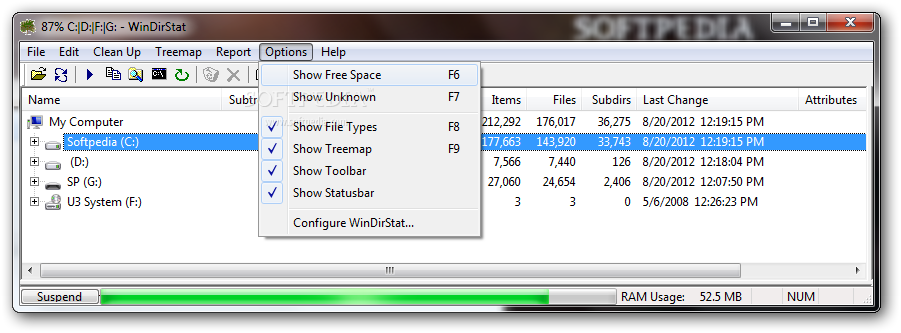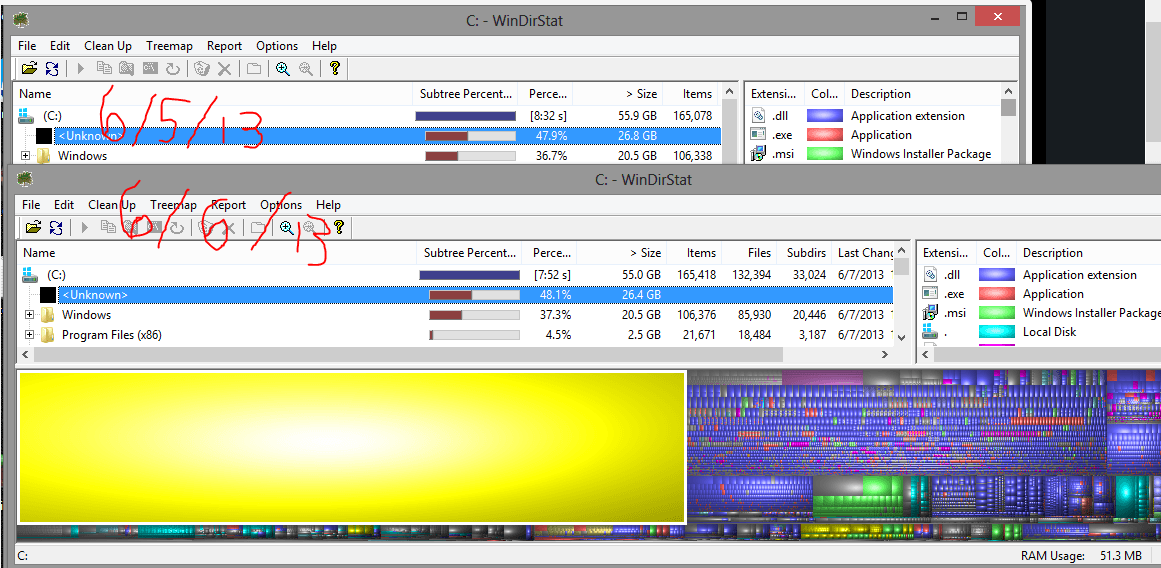

- #WINDIRSTAT UNKNOWN FILES DRIVERS#
- #WINDIRSTAT UNKNOWN FILES DRIVER#
- #WINDIRSTAT UNKNOWN FILES PLUS#
- #WINDIRSTAT UNKNOWN FILES WINDOWS 7#
- #WINDIRSTAT UNKNOWN FILES WINDOWS#
In a non-standard fashion, which was why Windirstat struggled with the report. Apparently, the files were useless, or maybe even created Have been a crazy startup script or a similar error.
#WINDIRSTAT UNKNOWN FILES DRIVER#
I do not know what triggered the weird creation of 12,500 folders containing the exact same driver set. The former had no more complaints about unknown files, and the disk usage Finally, I verified the printer functionality was unaffected by my deleteĪ subsequent scan with both Windirstat and TreeSize showed matched values in both tools, as you would expect, I also did not touch any other directories and files that I removed all of them apart from a single folder. At this point, armed with enough knowledge and intuition, Network printer, absolutely identical to one another.
#WINDIRSTAT UNKNOWN FILES DRIVERS#
For some weird reason, I had these thousands of instances of drivers for a particular

Perhaps these are corrupt files?īrowsing through the 圆4 directory, I soon learned there were roughly 12,500 of these, each containing theĮxact same set of DLL. Just as curious is the fact Windirstatĭid not reflect this information in its own report. There's no reason why you ought to have 50GB worth of printer drivers. It turns out most of it is located inside System32\spool\drivers.
#WINDIRSTAT UNKNOWN FILES WINDOWS#
Windows usage is 90GB rather than 35GB as Windirstat reported, and Indeed, TreeSize reveals a different result. However, it might help us get a better view of
#WINDIRSTAT UNKNOWN FILES PLUS#
It does it in a slightly different manner, plus less graphics. Anyhow, this utility has a similar functionality to Windirstat, but I'm a lumberjack, and I'm okay, I disk all night, and I check all day. Identify the unknown files, we need a different tool. And since Windirstat does not help us properly Problem, we need to understand if it is one in the first place. How we may have ended up with 55GB of space eaten by some mysterious data somewhere. But then, it does not really help us understand why or One of the recommendations is running chkdsk. Start implementing non-intrusive, non-destructive fixes first. I also most warmly recommend you backup any important personal data before commencing on a data freedom journey. Fiddling with systemįiles should not be done.

Which is why this article is also about what NOT to do. This makes it a little more difficult to find the right solution. You will see people mentioning all sorts of wizardry related to how Windows works and counts its disk space. Online for "Windows windirstat unknown file" as you may have actually done just before landing on this page, There are approximately a million different answers and solutions to this potential problem. Looked like something that should not be there. The presented data only amounted to about 60GB.īut there was a big chunk, labeled unknown, occupying 55GB of its own. Except in my case, it wasn't really helpful. It's a simple, no-nonsense tool, and it will display a detailed map and listing of all theįiles and folders. The obvious choice for this kind of task is Windirstat, which we have seen in useĪbout 18 months ago. Theġ20GB SSD was suddenly running short of space, even though it was supposed to be only about 50% utilized.
#WINDIRSTAT UNKNOWN FILES WINDOWS 7#
In addition, WinDirStat can display data about files of unknown types and disk space.Where has all the good space gone, and where are all the bytes? Where's the street-wise nerd to free up myĭisks? Anyhow, recently, I've come across a rather bizarre disk usage problem on one of my Windows 7 boxes. At the same time, you can quickly allocate all files of a certain type in the "mosaic" structure of the hard disk. Click on any file in the mosaic and you will be able to see its extension and the path to it. Working in WinDirStat is very easy: select a folder in the window where the tree structure of the disk is shown - and a piece of mosaic corresponding to this folder and the files included in it will be highlighted with a white frame. The program interface is divided into several windows - one window shows the tree structure of files, the other window shows the graphic "mosaic", and the third window shows the color designations for different types of files. In doing so, each folder can be expanded and looked at the structure of the files it contains (both folders and files are sorted by size). In addition to the graphical representation, folders on the disk can be displayed as a tree. The program scans the contents of the hard drive and displays its structure in the form of a mosaic in which - the larger the size of the file or folder - the larger the mosaic they are represented. WinDirStat is a very useful utility that can graphically show the structure of files and folders on the hard disk.


 0 kommentar(er)
0 kommentar(er)
